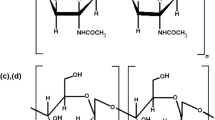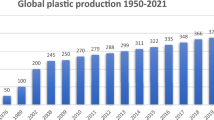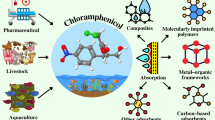Abstract
Tricarbonyl [(8,9,10,11-η-8,10-dodecadien-l-ol] iron and the corresponding acetate prepared from 8,10-dodecadien-1-ol or its acetate, comprise the protected double-bond system of the molecule. After coming in contact with ambient oxygen, the iron complexes in question slowly release the corresponding pheromones of, for example, the codling moth,Cydia pomonella, and the pea moth,Cydia nigricana in highE,E purity and amounts that are sufficient for pest monitoring. A simple dispenser for propheromone application is proposed. Results of release rates in laboratory conditions and field trials are given.
Similar content being viewed by others
References
Baker, T.C., Cardé, R.T., andMiller, J.R. 1980. Oriental fruit moth pheromone component. Emission rates measured after collection by glass surface absorption.J. Chem. Ecol. 6:749–758.
Bournoville, R. 1979. Determination, au champ, d'attractifs sexuels de synthèse des mâles de deux Tortricidae (Lep.):Laspeyresia medicaginis Kuzn. etLaspeyresia nigricana F., nuisibles aux legumineuses cultivées.Rev. Zool. Agric. Pathol. Veg. 78: 41–48.
Brown, D.F., andMcDonough, L.M. 1986. Insect sex pheromones. Formulation to increase the stability of conjugated dienes.J. Ecol. Entomol. 79:922–927.
DePuy, C.H., Jones, T., andParton, R.L. 1974. Chemistry of substituted hydroxybutadienetri-carbonyliron complexes.J. Am. Chem. Soc. 96:5602–5604.
Dunkelblum, E., Kehat, M., Klug, J.T., andShani, A. 1984. Trimerization ofErias insultana sex pheromone, (E,E)-10,12-hexadecadienal. A phenomenon affecting trapping efficiency.J. Chem. Ecol. 10(3):421–428.
Greé, R. 1989. Acyclic butadiene-iron tricarbonyl complexes in organic synthesis.Synthesis 341–355.
Greenway, A.R., 1984. Sex pheromone of the pea moth,Cydia nigricana (F.) (Lepidoptera: Olethreutidae).J. Chem. Ecol. 10:973–982.
Greenway, A.R., andWall, C. 1981. Attractant lures for males of the pea moth,Cydia nigricana (F.) containing (E)-10-dodecen-1-yl acetate and (E,E)-8,10-dodecadien-1-yl acetate.J. Chem. Ecol. 7:563–573.
Greenway, A.R.C.,Wall, C.,Bournoville, R., andEinhorn, J., 1983. Sex attractants for pea moth. Rep. Rothamstead Exp. Sta. 1982, Pt. 1, p. 128.
Horák, A., andHrdý, I. 1988. Attractiveness of (E)-10-dodecen-1-yl acetate for the pea moth,Cydia nigricana: modification by codlemone, codlemone acetate and dodecyl acetate.Acta Entomol. Bohemoslov. 85:174–181.
Horák, A., Hrdý, I., Krampl, F., andKalvoda, L. 1980. Polní zkoušky feromonových lapáku pro monitorová-ní obalece hrachového,Cydia nigricana. Sbor. UVTIZ-Ochr. Rostl. 16:213–225.
Horák, A., Hrdý, I., Konecný, K., andVrkoc, J. 1989. Effect of substrate formulation on the efficacy of the pea moth,Cydia nigricana, sex pheromone lures.Entomol. Exp. Appl. 53:125–131.
Hrdý, I., Konečný, K., andVrkoč, J. 1986. The effect of formulation on the effectiveness of codlemone for monitoring codling moth,Cydia pomonella. Sbor. UVTIZ-Ochr. Rostl. 22:33–52 (in Czech).
Ideses, R., andShani, A. 1987. Chemical protection of pheromones containing internal conjugated diene system, from chemical degradation in mating disruption: Behaviour of moth on molecules. Proc. Conf. 10CB-WPRS. H. Arn (ed.). pp. 66–67.
Ideses, R., Shani, A., andKlug, J.T. 1982. Sex pheromone of European grapevine moth (Lobesia botrana): Its chemical transformation in sunlight and heat.J. Chem. Ecol. 8:973–980.
Knox, G.R., andThom, I.G. 1981. Simple stereospecific syntheses of some insect pheromones using the Fe(CO)3 protecting group.J. Chem. Soc. Chem. Commun. pp. 373–374.
Liu, X., Macaulay, E.D.M., andPickett, J.A. 1984. Propheromones that release pheromonal carbonyl compounds in light.J. Chem. Ecol. 10:809–822.
Mahler, J.E., Gibson, D.H., andPetit, R. 1963. Organoiron complexes. III. Reaction of the syn-1-methylpentadienyl iron tricarbonyl cation.J. Am. Chem. Soc. 85:3955–3963.
McDonough, L.M., andButler, L.I. 1983. Insect sex pheromones: Determination of half-lives from formulations by collection of emitted vapor.J. Chem. Ecol. 9:1491–1502.
Morey, J., Greé, D., Mosset, P., Toupet, L., Greé, R. 1987. Synthesis and reactivity ofE,Z-butadiene-iron tricarbonyl complexes.Tetrahedron Lett. 28(26):2959–2961.
Nightingale, W.M. 1979. Improved means of obtaining sustained uniform emission of bioactive substances p. 401,in Proceedings, 1979 British Crop Protection Conference—Pests and Diseases. British Crop Protection Council, London.
Shani, A., andKlug, J.T. 1980. Sex pheromone of Egyptian cotton leafworm (Spodoptera litoralis): Its chemical transformation under field conditions.J. Chem. Ecol. 6:875–881.
Vrkoc, J., andStreinz, L. 1990. Conference on pheromones in Mediterranean pest management. Pheromones with conjugated double bonds: Problems in system for pest monitoring and mating disruption. Granada, 10–15 September.
Vrkoč, J., Konečný, K., Valterová, I., andHrdý, I. 1988. Rubber substrates and their influence on isomerization of conjugated dienes in pheromone dispensers.J. Chem. Ecol. 14:1347–1358.
Wall, C., Greenway, A.R., andBurt, P.E. 1976. Electroantennographic and field responses of the pea moth,Cydia nigricana, to sex attractants and related compounds.Physiol. Entomol. 1:151–157.
Wall, C., Bournoville, R., Greenway, A.R., andEinhorn, J. 1987. Efficacy and stability of sex attractant lures forCydia nigricana (F.) andCydia medicaginis (Kuzn.).Crop protect. 6:7–12.
Zeoli, L.T., Kydonieus, A.F., andQuisumbing, A.R. 1982. Controlled release technologies, pp. 131–144,in A.F. Kydonieus and M. Beroza (eds.). Insect Suppression with Controlled Release Pheromone System, Vol. I. CRC Press, Boca Raton, Florida.
Author information
Authors and Affiliations
Rights and permissions
About this article
Cite this article
Streinz, L., Horák, A., Vrkoč, J. et al. Propheromones derived from codlemone. J Chem Ecol 19, 1–9 (1993). https://doi.org/10.1007/BF00987466
Received:
Accepted:
Issue Date:
DOI: https://doi.org/10.1007/BF00987466




